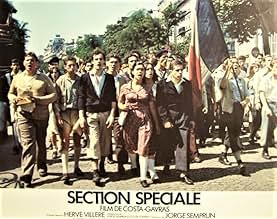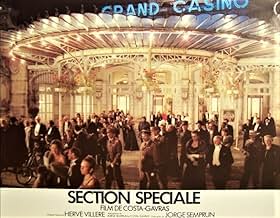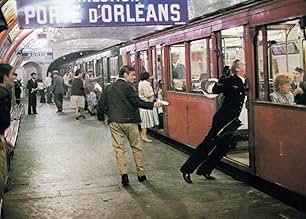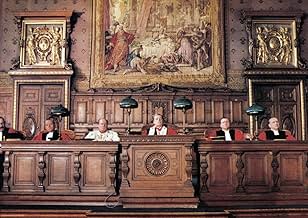Section spéciale
- 1975
- Tous publics
- 1h 58min
Dans la France occupée pendant la Seconde Guerre mondiale, un officier allemand est assassiné. Le gouvernement de Vichy décide de faire endosser le crime à six petites frappes. Des magistrat... Tout lireDans la France occupée pendant la Seconde Guerre mondiale, un officier allemand est assassiné. Le gouvernement de Vichy décide de faire endosser le crime à six petites frappes. Des magistrats loyaux au régime sont convoqués pour les reconnaître coupables le plus vite possible.Dans la France occupée pendant la Seconde Guerre mondiale, un officier allemand est assassiné. Le gouvernement de Vichy décide de faire endosser le crime à six petites frappes. Des magistrats loyaux au régime sont convoqués pour les reconnaître coupables le plus vite possible.
- Réalisation
- Scénario
- Casting principal
- Récompenses
- 2 victoires et 2 nominations au total
- Pierre Pucheu, le ministre de l'Intérieur
- (as Michel Lonsdale)
Avis à la une
Although Costa-Gavras made his movie accessible to everyone (story telling has always been his forte,even in his American career),he did not try to sweeten the screenplay with love affairs or melodrama (the past of one of the victims,played by Yves Robert ,is almost treated with nonchalance and casualness).Although there is no superstar here (nobody like Yves Montand) most of the actors,even in small parts,were widely known by the French audience of the seventies: his producer,Jacques Perrin,had been the rebellious journalist in "Z" and he portrays the only lawyer who really "plays".
But Costa-Gavras's best idea for the casting is the choice of Claude Pieplu as the presiding judge: his high-pitched voice -it's necessary to see the movie in French with subtitles- works wonders,so to speak,and I can't see no other French actor in this part.This man was so talented he would convince you that all he did was for the sake of his homeland.
During the trial of Marechal Philippe Pétain the prosecutor referred to the 'Exceptional Courts' as 'a monstrous institution', a description which no decent human being would dispute. Following the shooting of a German midshipman in the Barbes-Rochechouart Métro by a Communist activist who would later achieve renown as Colonel Fabien, the Nazis had threatened to execute an hundred French hostages, regardless of rank or celebrity. Ostensibly to save French lives and appease his German masters, Pétain instigated the 'section spéciale' to pass sentence of death on a handful of token prisoners classed as 'undesirables' who had previously been given lighter sentences for minor crimes. It only remained to appoint the judges whose major qualifications were ambition, amorality, cowardice or a combination thereof.
This utterly grotesque situation lends itself to the blackest of humour and Gavras does not fall short in this regard, not least in the executioners hanging around the court impatiently awaiting the names of those they are to guillotine. What is most effective however is how the legislative charade and parody of justice are carried out with the most proper ceremony. As Michel Benon, president of the Special Court, Claude Piéplu again excels as the man you love to hate.
Although the film ends by informing us that none of the judges faced sanctions for their activities in fact the Minister of Justice at the time, Joseph Barthélemy, superbly played by veteran Louis Séigner, was tried by the High Court but died of cancer before the end of legal proceedings. The egregious Minister of the Interior, Pierre Pucheu, a chilling portrayal here by Michel Lonsdale, was destined, ironically, to be sentenced by a Special Court and executed by firing squad.
There is some justice after all.
This film is part of the lineage that includes The Sorrow and the Pity (Le Chagrin et la Pitié, 1969) and Lacombe Lucien (1974), but it differs in focus. Where those films examine attitudes, behaviors, and emotional states under occupation, this one dissects institutional collaboration - specifically the judicial system's transformation into an obedient executor of Nazi demands. Stylistically, it is more clinical than its predecessors. It avoids the sentimentality or psychological drama that Lacombe Lucien allowed to seep in, opting instead for a calculated, almost Kubrickian austerity that keeps the audience at a remove. There is no overt emotional manipulation in the mise-en-scène; no swelling music or pointed visual cues to tell us how to feel. The horror lies in the banality, and the camera knows it. Static frames dominate, mirroring the rigidity of judicial decorum and the paralysis of ethics.
Visually, the film is meticulous, often using architectural symmetry and stark lighting to emphasize the mechanized, depersonalized operations of the court. Interiors - all paneling, polished brass, and dim lamplight - are rendered with an oppressive stillness that communicates the suffocating morality vacuum in which these officials function. The costuming is likewise precise, capturing the somber formality of Vichy France's legal elite, all robes and ritual, masking the rot beneath.
The performances follow suit. This is not a film driven by actorly bravura, but by a measured, near-sociological approach to character. The cast moves with a quiet dread, underplaying rather than emoting, which lends the entire enterprise an eerie plausibility. No one plays a villain in the conventional sense - which is precisely the point. The most chilling figures are those who appear to believe, or convincingly pretend to believe, in the legitimacy of their duties. One notable exception is a senior judge whose restrained performance betrays just the slightest quiver of conscience - never voiced, only momentarily glimpsed in a faltering hand or an elongated pause - suggesting the silent tension between professional decorum and moral corrosion.
Contextually, 1975 France was grappling with a period of deep self-examination. The Gaullist myth of widespread resistance had begun to erode in public discourse, partly due to the political climate of the 1970s - student protests, Vietnam, and postcolonial anxieties - which had reoriented cultural attention toward systemic critique. This film reflects that shift. It isn't merely about collaboration; it is about how systems, supposedly designed for justice, can be turned inside out to serve tyranny - and how those who operate within them justify their obedience. The movie's attention to legal ritual - the precise language, the ceremonial dress, the self-serious procedures - makes clear how collaboration is not always enacted with guns and salutes, but with signatures and sentence reductions.
Technically, the film's sound design stands out for its restraint. There is minimal non-diegetic music, and what little exists serves to punctuate rather than embellish. Silence - or the muffled ambiance of closed-door meetings - becomes a weapon, reinforcing the isolation of those who are about to be sacrificed on the altar of political expediency. The pacing may frustrate some viewers accustomed to more dynamic storytelling, but its slowness is deliberate, mirroring the gradual, grinding momentum of bureaucratic injustice. This is a machine at work, and the viewer is not meant to be entertained so much as implicated.
If there's a point of comparison that reveals the specific achievement of this film, it might be The Assassination of Matteotti (Il delitto Matteotti, 1973), which similarly explores how fascist ideology seeps into the procedural and institutional fabric of a society. Both films share a preoccupation with how "normal" men of the state become facilitators of repression, not through fanatical violence, but through a perversion of legality. However, where Il delitto Matteotti leans more into overt political drama and historical speech, this film prefers ambiguity and understatement, assuming the viewer can read between the silences and ceremonial lines.
Another worthwhile comparison might be with The Trial Begins (El proceso empieza, 1960s, Spain), a lesser-known Spanish film centered around the Francoist courts. Like the movie in question, it emphasizes legal choreography as a mechanism of state violence, though it lacks the formal rigor and detached poetics seen here. Still, both films gesture toward a shared concern with how authoritarian systems inscribe their violence through the law, making injustice seem inevitable - even rational.
The cinematography makes subtle use of framing to reinforce the ideological claustrophobia. High-angle shots that look down on characters during pivotal decisions emphasize their lack of autonomy, while low-angle perspectives used sparingly hint at the grotesque self-importance with which some of the judges carry out their duties. The lighting, never expressive, becomes more shadowed as the story progresses, creating a visual metaphor for the moral descent taking place behind the scenes.
There is also a disturbing irony at play throughout, never overstated, but made palpable through editing choices that linger just long enough to make the viewer uncomfortable. Reaction shots from bureaucrats during key moments - usually cut just a beat too late - betray the slight satisfaction, the quiet dread, or the total indifference that these men feel as they enact policies under the guise of national interest. These micro-expressions become testimonies more damning than any written decree.
What this film accomplishes - and few others do with such quiet venom - is to show how evil can drape itself in tradition, legalism, and the rhetoric of stability. Its targets are not monsters but administrators. And in choosing to observe rather than dramatize, the film refuses the comfort of moral distance. We watch, impotent, as the machinery grinds forward. The film doesn't accuse directly; it simply invites us to look - and then dares us to look away.
That said, for all its conceptual rigor and political force, this is not a film without cinematic limitations. The direction embraces an austerity that, while coherent with the film's dry, accusatory tone, exposes certain shortcomings when viewed through a more formal lens. Costume and makeup design are serviceable but lack texture or historical depth. There is little visual richness to immerse the viewer in the era - a deliberate rejection, perhaps, of period-piece aestheticism, but one that occasionally flattens the screen rather than sharpening it.
Similarly, the dialogue, while precise in its argumentative function, sometimes lapses into repetition or stiffness. Characters serve the thesis rather than embodying emotional or psychological nuance. This discursive mode, though effective in sustaining the film's political clarity, can weigh down the dramatic vitality. The narrative moves at a deliberate, at times sluggish pace, and the repetition of judicial procedures - realistic as it may be - borders on the mechanical.
These choices, arguably necessary to preserve the film's ideological clarity, come at a cost to its cinematic fullness. Judged strictly on formal terms, a more restrained rating - something closer to 7 out of 10 - would be reasonable. But insofar as one values its historical precision, thematic courage, and unique position within the cinema of Nazi occupation and institutional collaboration, the higher score - 9 out of 10 - stands not as a marker of aesthetic perfection, but of intellectual and political urgency.
As expect many magistrates turn down the crying shame ruling, then they have carefully pick up the greediest judges for the power passing over legal principles aiming for earnings by promotion on high-ranking of French justice, worst they have to overturn the district attorney's office and all lawyers as well to condemn to death everyone less fortunate by a light offence.
Thanks for reading.
Resume:
First watch: 2024 / How many: 1 / Source: DVD / Rating: 8.
Le saviez-vous
- AnecdotesAll the names of the accused are real. Abraham Trzebrucki, André Bréchet, Émile Bastard, Lucien Sampaix, etc.
- GaffesWhen two of the judges have lunch on a restaurant patio, two members of the French Milice, wearing the gamma insignia, are sitting at a table behind. The action is set in summer 1941 but the Milice, subordinated to the French government in Vichy was created in January 1943.
- ConnexionsFeatured in Costa-Gavras Talks with Marcel Ophuls (1976)
Meilleurs choix
- How long is Special Section?Alimenté par Alexa
Détails
- Durée1 heure 58 minutes
- Mixage
- Rapport de forme
- 1.66 : 1

































